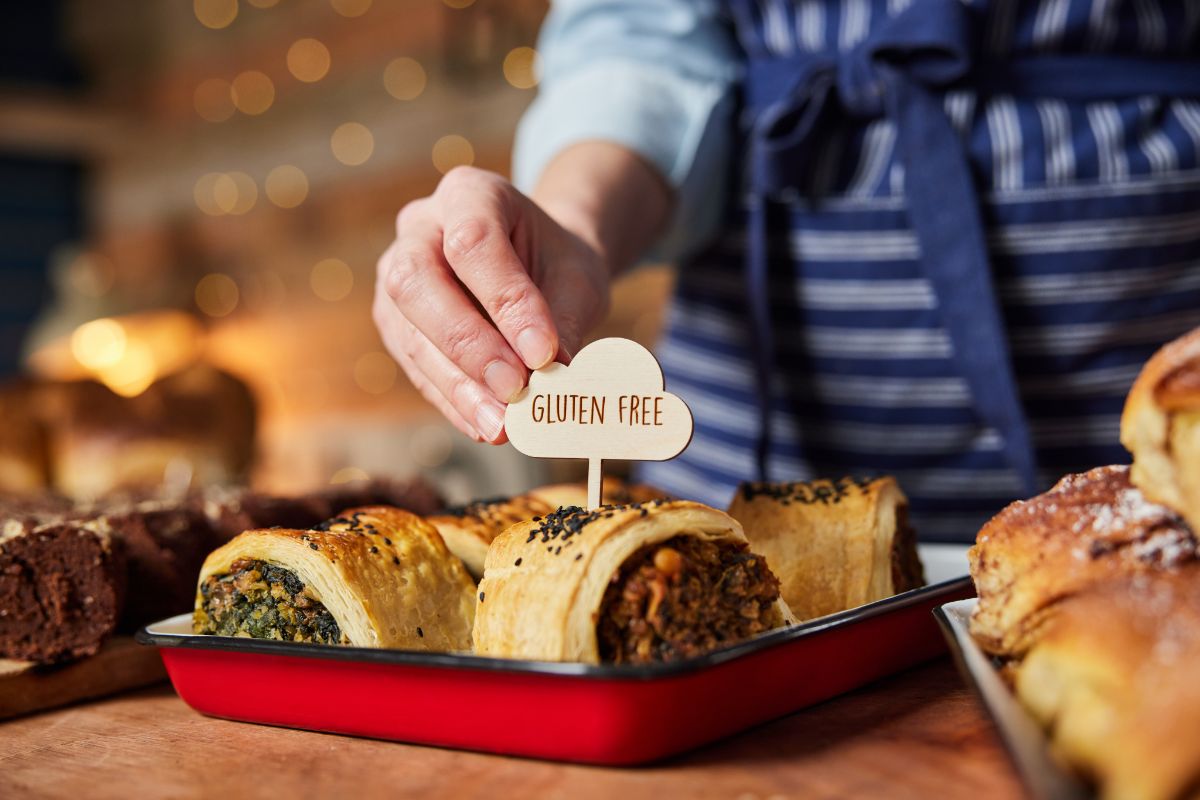
Where can gluten-free dieters find a mouth-watering meal?
To mark Celiac Disease Awareness Month in May, LawnStarter ranked 2023’s Best Cities for Gluten-Free Food.
We compared the 200 biggest U.S. cities based on five categories. We looked at access to vendors with gluten-free options, celiac disease healthcare practitioners, and gluten intolerance support groups, among 14 total metrics.
Bite into our ranking below. To learn how we ranked the cities, see our methodology.
Contents
City Rankings + Infographic
See how each city fared in our ranking:

Top 5 Close Up
Check out the slideshow below for highlights and lowlights on each of our top five cities.
Key Insights
The Gluten-Free Gist
Big cities like New York (No. 1), San Francisco (No. 2), and Boston (No. 3) are perfect for gluten-free gluttons: They offer plenty of celiac-friendly options to appease large populations of hungry, gluten-sensitive folks. Some smaller cities stand out, such as Charleston, South Carolina (No. 5), and Savannah, Georgia (No. 15), with highly rated gluten-free options.
Suburban areas fell to the bottom of our ranking, with West Valley City, Utah (No. 197), North Las Vegas, Nevada (No. 198), and Moreno Valley, California (No 199), landing alongside Fontana, California, in last place. Thankfully, the central cities nearby — Salt Lake City (No. 27), Las Vegas (No. 8), and Riverside, California (No. 100) — have better gluten-free options.
Standout Stats
Big Apple Appetites: Gluten-intolerant foodies can flock to our top city, New York, to find meals that taste good without making their stomachs feel bad. New York has the highest Demand for gluten-free options and the largest gluten-free Community. NYC also offers the most health markets and seventh-best access to vendors selling gluten-free food.
Gluten-Free Gold: Our No. 2 city, San Francisco, boasts the top access to food vendors and pizza vendors with gluten-free choices, followed by Alexandria, Virginia (No. 11), Boston (No. 3), and Washington (No. 7) in both metrics. The Golden City can also appease travelers, thanks to the third-highest number of gluten-free options at airports.
Celiac-Friendly Confections: Satisfy your sweet tooth in Boston, which dishes out the most dessert vendors and bakeries with gluten-free alternatives. Boston dominates in Health Care Access, with the most celiac disease healthcare practitioners per 100,000 residents and a high number of gastroenterologists.
Hungry for More: Only eight Texas cities end in the top half of our ranking, with the remaining 17 disappointing gluten-free diners. Gluten-free food vendors in Pasadena (No. 26), Dallas (No. 37), and Austin (No. 40), impress with high consumer ratings. Meanwhile, many Lone Star cities, especially Fort Worth (No. 181), El Paso (No. 182), and Killeen (No. 195), fall behind in Food Access and Food Quality.
Hollywheat: Gluten-free diets have become popular amongst celebrity circles. Despite having the second-highest Demand, Los Angeles landed at No. 23 in Access and No. 70 in Food Quality. LA lags behind other big cities in access to gluten-free vendors, but does offer the eighth-highest number of health markets.
Chucktown Chefs: Though it might not have the best Access to gluten-free food, Charleston, South Carolina (No. 5) serves up the highest Food Quality, followed by New Orleans (No. 13). Charleston also boasts the best access to gastroenterologists.
Ask The Experts
There are plenty of false notions about gluten-free diets, such as who they benefit and how — not to mention stereotypes about flavorless gluten-free food.
That’s why we reached out to a panel of experts to provide some insights, in addition to their tried-and-tested GF-certified recipes.
- Who needs to follow a gluten-free diet?
- What is the biggest misconception about gluten-free diets?
- How can gluten-free food makers step up their flavor game?
- What’s the difference between gluten intolerance and gluten sensitivity?
- What are the common symptoms of celiac disease or gluten intolerance or sensitivity? What’s the next step if you detect symptoms?
- What is one of the most creative gluten-free dishes or recipes you’ve encountered?
- What are three less obvious places to get gluten-free food?




Who needs to follow a gluten-free diet?
Patients that have been officially diagnosed with celiac disease by their physicians should follow a gluten-free diet. In addition, those patients that are not found to have celiac, but have symptoms of abdominal discomfort and bloating after eating gluten may also benefit from a gluten-free diet. The latter may have gluten sensitivity and, to date, there is no test available for that.
What is the biggest misconception about gluten-free diets?
The greatest misconception is that gluten-free is the same as a wheat-free diet.
How can gluten-free food makers step up their flavor game?
Maybe by adding extra vanilla or other spices!
What’s the difference between gluten intolerance and gluten sensitivity?
Gluten sensitivity is when the symptoms after eating gluten are mild and temporary. Gluten intolerance is when the symptoms after eating gluten are more severe and long-lasting, but the patient does not have celiac.
What are common symptoms of celiac disease or gluten intolerance or sensitivity? What’s the next step if you detect symptoms?
The symptoms of celiac disease, gluten intolerance, and gluten sensitivity are as below: Bloating, abdominal pain after eating, diarrhea, anemia, iron deficiency, and weight loss. However, constipation may also be seen in patients with celiac. Some patients can have a rash called dermatitis herpetiformis (an itchy rash with small blisters).
If a person has symptoms, they should see their primary doctor and get blood tests done. Upper endoscopy with biopsy is often needed to confirm the diagnosis.
What is one of the most creative gluten-free dishes or recipes you’ve encountered?
I THINK THE GLUTEN-FREE SALADS ARE THE BEST!
What are three less obvious places to get gluten-free food?
- Italian restaurants (unless they have a gluten-free menu)
- Chinese food (unless they have a gluten-free menu)
- Fast foods (unless they have a gluten-free menu)

Who needs to follow a gluten-free diet?
- Those diagnosed with celiac disease and wheat allergy, though many people self diagnose gluten sensitivity. None of the studies show that these people have a gluten issue, rather they are sensotive to fructans found among the FODMAPs.
What is the biggest misconception about gluten-free diets?
- That the gluten-free diet is healthy. Those without celiac disease who don’t consume much gluten have increased rates of diabetes (type 2) and heart disease.
What’s the difference between gluten intolerance and gluten sensitivity?
- Gluten intolerance can be an umbrella term for all people who avoid gluten, including celiac disease (CD), wheat allergy, eosinophillic disorders, as well as those with a sensitivity which is also called non-celiac gluten sensitivity (NCGS). Whereas, with gluten sensitivity, we think that there is no definable pathology and it is usually self-identified and not typically diagnosed by MDs. Many of those who self-identify and self-treat as NCGS may have CD.
- CD is an autoimmune disease, unique among autoimmune diseases because we know the environmental precipitant: gluten.
What are common symptoms of celiac disease or gluten intolerance or sensitivity? What’s the next step if you detect symptoms?
- IBS-like symptoms — altered bowel movements, diarrhea and bloating — these occur in CD and NCGS. No symptoms, but presentations with anemia or osteoporosis are also presentations for CD.
- First test is a blood test for specific antibodies to tissue transglutaminase and gliadin, and, if positive, an intestinal biopsy at endoscopy that shows atrophy of the intestine allows the diagnosis.
What is one of the most creative gluten-free dishes or recipes you’ve encountered?
- Polenta made as crackers that can be served with something on top. Simple rice, beans, and collard greens.
What are three less obvious places to get gluten-free food?
- Most obvious are very fancy restaurants; least are African restaurants that use teff or sorghum as their grains.

Who needs to follow a gluten-free diet?
Gluten-free foods are intended for consumers with celiac disease. Celiac disease is triggered by gluten proteins from wheat, rye, barley, and related grains (spelt, durum, semolina, emmer, einkorn, etc.). Other consumers may follow gluten-free diets due to wheat allergy, barley allergy (quite rare), non-celiac gluten sensitivity (an emerging but still confusing diagnosis), or dermatitis herpetiformis.
What is the biggest misconception about gluten-free diets?
Many consumers without any of the above-listed maladies still follow gluten-free diets although perhaps not a rigidly as consumers with actual diseases that are provoked by gluten. The biggest misconception is that gluten-free diet can assist with weight loss. There is no clinical evidence, but skipping bread, pasta, and pizza may help some to lose weight. But that is related to calorie levels, so it will depend on the nature of the items in your diet that replace gluten.
How can gluten-free food makers step up their flavor game?
The biggest issue is texture rather than flavor. Many desirable gluten-free products are now on the market in my opinion.
What’s the difference between gluten intolerance and gluten sensitivity?
There are many terms used by consumers and perhaps all of them are intended to mean that they cannot or do not wish to eat gluten. Two related conditions in terms of symptoms are celiac disease (also known in medical circles as gluten-sensitive enteropathy) and non-celiac gluten sensitivity. These two conditions can be distinguished in diagnosis but both cause intestinal malabsorption and digestive problems.
Wheat allergy is different because the onset time is very rapid (celiac symptoms often take a few days to develop), and the symptoms are more severe and involve more organ systems (breathing difficulty, hypotension, hives, etc. not seen with celiac). And consumers with wheat allergy can eat barley and rye so long as they are not contaminated with wheat.
What are common symptoms of celiac disease or gluten intolerance or sensitivity? What’s the next step if you detect symptoms?
Celiac disease is a malabsorption disease. The intestinal tract of affected consumers loses its ability to properly absorb nutrients from the diet. Diarrhea and gastrointestinal upset can ensue. But nutritional imbalances can also result, such as anemia (due to lack of iron) and osteoporosis (due to lack of calcium). Weight loss can occur if untreated. Treatment is a life-long gluten-free diet. Non-celiac gluten sensitivity is very similar but lacks certain diagnostic markers of celiac disease.
When consumers detect symptoms or have suspicions, they should make an appointment with a gastroenterologist who can do several diagnostic tests to confirm the existence of celiac disease.
What is one of the most creative gluten-free dishes or recipes you’ve encountered?
I was heartened when I saw retail availability of gluten-free Bisquick. Today there are many excellent gluten-free products.
What are three less obvious places to get gluten-free food?
Gluten-free products are often quite obvious because they are very clearly labeled. Of course, some foods are inherently gluten-free and don’t have such labels such as fresh fruits and vegetables, raw meats, etc.
Methodology
First, we determined the factors (metrics) that are most relevant to rank the Best Cities for Gluten-Free Food. We then assigned a weight to each factor based on its importance and grouped those factors into five categories: Food Access, Food Quality, Demand, Health Care Access, and Community. The categories, factors, and their weights are listed in the table below.
For each of the 200 biggest U.S. cities, we then gathered data on each factor from the sources listed below the table.
Finally, we calculated scores (out of 100 points) for each city to determine its rank in each factor, each category, and overall. A city’s Overall Score is the average of its scores across all factors and categories. The highest Overall Score ranked “Best” (No. 1) and the lowest “Worst” (No. 200).
Note: The “Worst” among individual factors may not be No. 200 due to ties.
Sources: American Academy of Allergy, Asthma & Immunology, Celiac Disease Foundation, Eatright.org, Find Me Gluten Free, GI Alliance, Gluten Intolerance Group, Google Ads, Meetup, TripAdvisor, and Yelp
Media Resources
- High-resolution image of infographic
- High-resolution images of cities
- 2022’s Best Cities for Gluten-Free Food ranking
Main Photo Credit: Shutterstock









